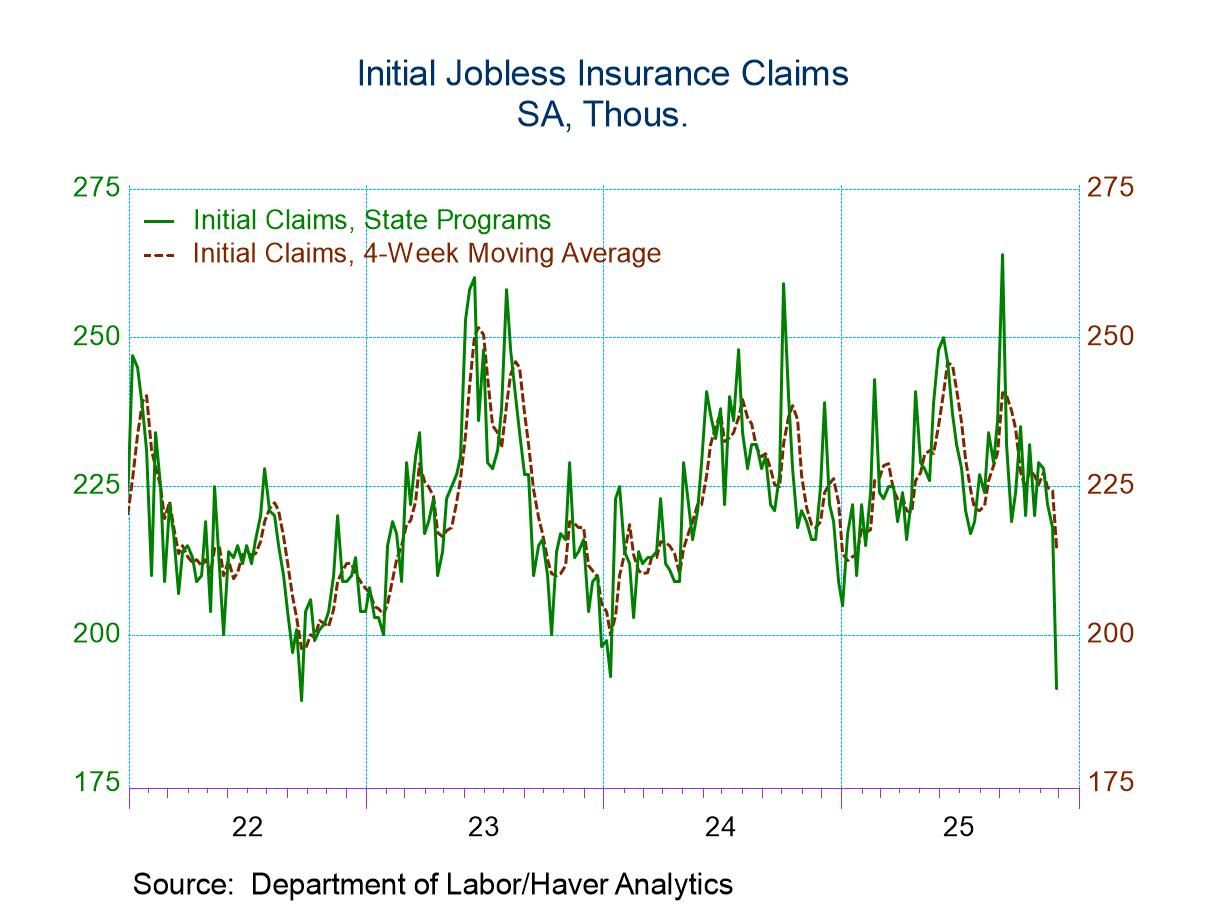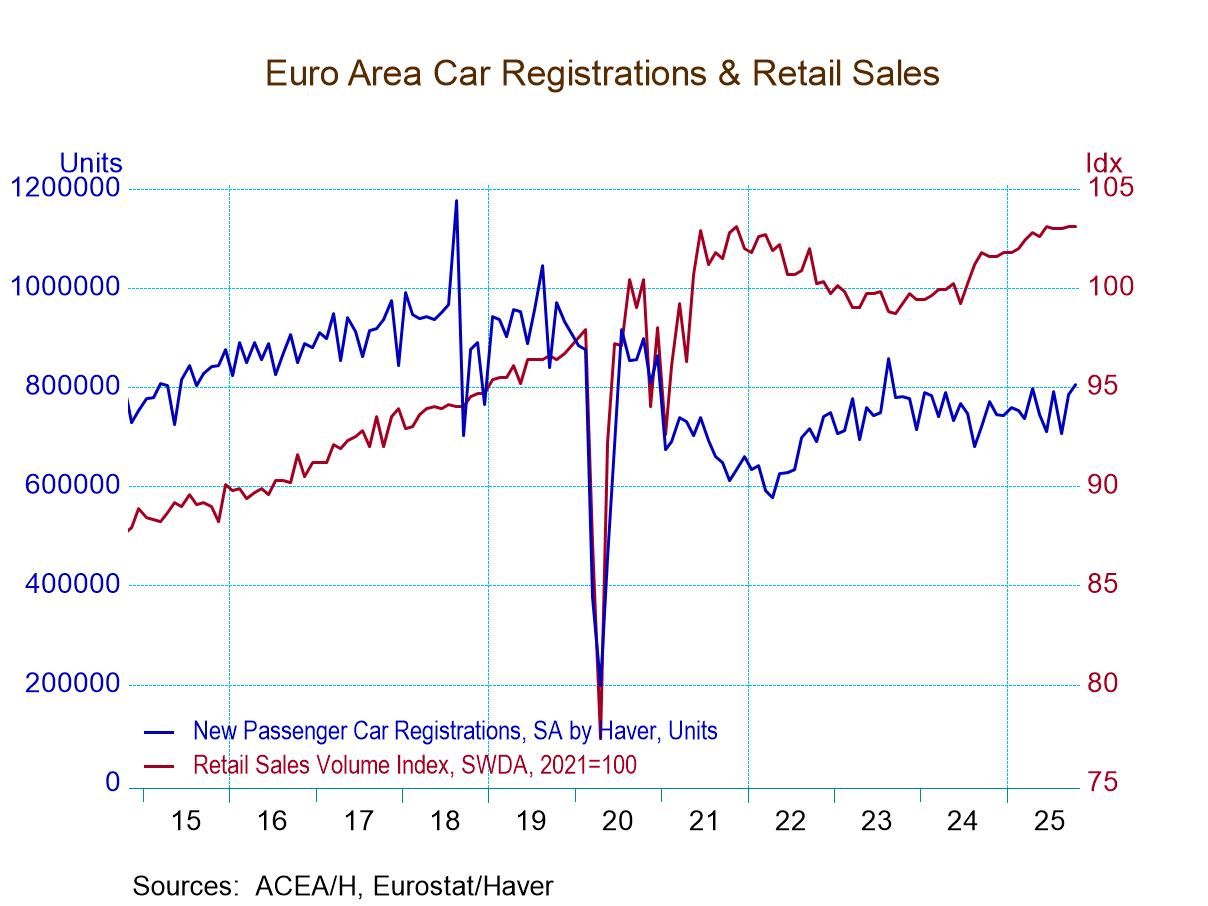 Global| Nov 25 2015
Global| Nov 25 2015U.S. Personal Spending Inches Higher as Income Strengthens
by:Tom Moeller
|in:Economy in Brief
Summary
Personal consumption expenditures improved 0.12% (2.9% y/y) in October, the same as September's rise which was unrevised. These were the smallest gains since January and missed expectations for a 0.3% rise in the Action Economics [...]
Consumers are exhibiting cautious spending behavior despite
firm income gains. Personal consumption expenditures
improved 0.12% (2.9% y/y) in October, the same as September's rise which was
unrevised. These were the smallest gains
since January and missed expectations for a 0.3% rise in the Action Economics
Forecast Survey. Adjusted for inflation, spending inched 0.06% higher (2.7%
y/y). A 0.7% decline (+3.4% y/y) in real motor vehicle purchases held back the
overall rise, though it followed three months of increase. Constant dollar buying of recreational goods &
vehicles made up that weakness with a 0.9% rise (8.4% y/y) after a 0.8%
increase. Home furnishings & appliance purchases increased 0.6% (6.2% y/y)
in constant dollars following a 0.1% dip. In the nondurable goods sector, real
apparel purchases surged 0.8% (4.3% y/y) after a 0.5% rise. Real gasoline
purchases fell 0.3% (+2.0% y/y) after a 1.5% decline and the constant dollar value of eating out
dropped 0.8% (-0.3% y/y), down for the third month in the last four. Real spending on services
was unchanged (2.2% y/y) after a 0.2% increase. Real spending on recreation services rose
0.5% (0.3% y/y) after a 1.0% jump but constant dollar housing & utilities
outlays fell 0.8% (+0.8% y/y). Health care spending advanced 0.4% (4.1% y/y) in real terms,
the same as the prior month.
Personal income improved 0.4% (4.6% y/y) for the third time in four
months. The increase matched expectations and reflected a 0.6% gain (4.9% y/y)
in wage & salary
income after having been unchanged in September.
Rental income jumped 0.8% (7.2% y/y), the strongest increase in four months. Proprietors
earnings rose 0.3% (2.8% y/y) after a 0.4% rise. Dividend earnings jumped 0.9%
(5.5% y/y), the strongest rise in three months, but interest earnings fell 0.2%
(+3.4% y/y) following three straight 0.1% upticks. Transfer receipts improved
0.3% (4.9% y/y), the same in the prior month. The gain was held back
by a 2.8% decline (+1.0% y/y) in unemployment insurance benefits but Medicaid income rose
0.7% (7.6% y/y). Veterans benefits also rose 0.7% (12.1% y/y) and Medicare
payments improved 0.5% (4.0% y/y). Disposable personal income jumped 0.4% and gains have been fairly steady for
the last six months. The 4.1% y/y rise matched growth during all of last year.
Adjusted for price inflation, take-home pay rose 3.9% y/y, up from the 2.7%
increase last year. The personal savings rate improved to 5.6% from 5.3%, revised from
4.8%. The rate was the highest since 2012. Personal saving increased 30.7%
during the last twelve months. The chain price index improved 0.1% (0.2% y/y) following two months of
slight decline. The index change was held back by a 0.2% dip (2.0% y/y) in
durable goods prices but food prices improved 0.2% (0.8% y/y) for the fourth straight
month. Nondurable goods prices eased slightly (-3.7% y/y) while energy prices
gained 0.2% (-18.4% y/y). Services prices
improved 0.1% (1.9% y/y) after two months of 0.2% rise. The price index excluding
food & energy remained unchanged (1.3% y/y) after a 0.2% rise. The personal income & consumption figures are available in Haver's USECON
database with detail in the USNA database. The Action Economics figure is
in the AS1REPNA database. Global Fallout from China's Industrial Slowdown from the Federal
Reserve Bank of San Francisco is available here http://www.frbsf.org/economic-research/publications/economic-letter/2015/november/global-fallout-from-china-industrial-slowdown/?utm_source=frbsf-home-economic-letter-title&utm_medium=frbsf&utm_campaign=economic-letter
Personal Income & Outlays
(%)
Oct
Sep
Aug
Y/Y
2014
2013
2012
Personal Income
0.4
0.2
0.4
4.6
4.4
1.1
5.0
Wages & Salaries
0.6
0.0
0.4
4.9
5.1
2.7
4.5
Disposable Personal Income
0.4
0.2
0.4
4.1
4.2
-0.1
5.1
Personal Consumption Expenditures
0.1
0.1
0.3
2.9
4.2
3.1
3.4
Personal Saving Rate
5.6
5.3
5.2
4.5
(Oct. '14)4.8
4.8
7.6
PCE Chain Price Index
0.1
-0.1
-0.0
0.2
1.4
1.4
1.9
Less Food & Energy
0.0
0.2
0.1
1.3
1.5
1.5
1.9
Real Disposable Income
0.4
0.3
0.4
3.9
2.7
-1.4
3.1
Real Personal Consumption Expenditures
0.1
0.1
0.3
2.7
2.7
1.7
1.5
U.S. New Home Sales Weaken but Prices Rebound
by Tom Moeller November 25, 2015
Recent housing market data are throwing off mixed signals. On the heels of Thursday's report that existing home sales in September neared a nine-year high, today's indication that new single-family home sales fell 11.5% last month to 468,000 (AR) left them up 2.0% y/y as the prior two months were revised lower. Sales were at the lowest level since November. Expectations had been for 547,000 sales in the Action Economics Forecast Survey.
The median price of a new single-family rose 2.7% (13.5% y/y) to $296,000. The reversal of an August decline left them at this year's highest level and one-third firmer than the 2010 average. The average price of a new single-family home jumped 6.2% (14.1% y/y) to $364,000, the highest level since December.
Home sales were notably weak last month in the Northeast as they fell 61.8% to 13,000 (-56.7% y/y). Sales in other regions of the country also declined but to lesser degrees. In the South, sales were off 8.7% to 274,000 but rose 8.3% y/y. Sales in the Midwest fell 8.3% both m/m and y/y to 55,000 and sales in the West declined 6.7% to 126,000 (+8.6% y/y).
The easing of home sales prompted a rise in the supply of homes on the market to 5.8 months at the current sales rate, the highest level since July of last year. Working the other way, however, the median number of months a home was on the market declined to 3.3, the least since February.
Five Questions Related to U.S. Monetary Policy is the title of St. Louis Fed President & CEO James Bullard's speech and it can be found here https://www.stlouisfed.org/news-releases/2015/11/20/st-louis-feds-bullard-discusses-five-questions-related-to-us-monetary-policy
The data in this report are available in Haver's USECON database. The consensus expectation figure from the Action Economics survey is available in the AS1REPNA database.
| U.S. New Single-Family Home Sales (SAAR, 000s) | Oct | Sep | Aug | Oct Y/Y % | 2014 | 2013 | 2012 |
|---|---|---|---|---|---|---|---|
| Total | 468 | 529 | 2.0 | 440 | 430 | 368 | |
| Northeast | 13 | 34 | -56.7 | 28 | 31 | 29 | |
| Midwest | 55 | 60 | -8.3 | 58 | 61 | 47 | |
| South | 274 | 300 | 8.3 | 244 | 233 | 195 | |
| West | 126 | 135 | 8.6 | 110 | 106 | 97 | |
| Median Price (NSA, $) | 296,900 | 289,100 | 13.5 | 283,775 | 265,092 | 242,108 |
Tom Moeller
AuthorMore in Author Profile »Prior to joining Haver Analytics in 2000, Mr. Moeller worked as the Economist at Chancellor Capital Management from 1985 to 1999. There, he developed comprehensive economic forecasts and interpreted economic data for equity and fixed income portfolio managers. Also at Chancellor, Mr. Moeller worked as an equity analyst and was responsible for researching and rating companies in the economically sensitive automobile and housing industries for investment in Chancellor’s equity portfolio. Prior to joining Chancellor, Mr. Moeller was an Economist at Citibank from 1979 to 1984. He also analyzed pricing behavior in the metals industry for the Council on Wage and Price Stability in Washington, D.C. In 1999, Mr. Moeller received the award for most accurate forecast from the Forecasters' Club of New York. From 1990 to 1992 he was President of the New York Association for Business Economists. Mr. Moeller earned an M.B.A. in Finance from Fordham University, where he graduated in 1987. He holds a Bachelor of Arts in Economics from George Washington University.






